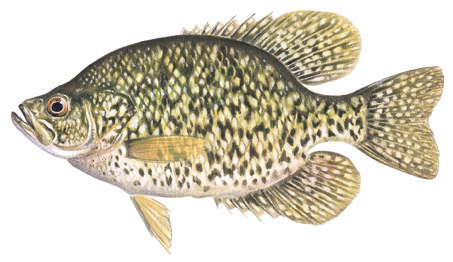Common Names: black crappie, crappie.
Habitat
Black crappies are found throughout southern Ontario and in northwestern Ontario extending only slightly north of Lake Superior. The number of water bodies containing black crappies is increasing due to migration through canal systems. Black crappies prefer slightly clearer water than the white crappie. Crappie usually travel in moderate to large schools and are highly mobile. In the spring they can be found in the warmest waters in the lake, usually shallow bays where the ice-off is the earliest. Later in the year they can be found off of deep points and they remain there throughout the winter.
Spawning Patterns
Spawning occurs in late spring and early summer when water temperatures reach about 20 ºC (68 ºF). Spawning occurs in water shallower than 60 cm (2 feet). Spawning areas usually have lots of vegetation. Fallen trees also provide good spawning cover. Females regularly spawn with more than one male. One female is capable of producing 65,000 eggs with the average being around 37,000. Eggs hatch in under a week and the fry stay around the nest for a few days in the protection of the male.
Diet
Aquatic larvae make up the largest portion of the diet, but also present in the diet are insects and other fish. Fish ingested are usually under 6.5 cm (2.5”) but range from a wide variety of minnows and other game fish including the juveniles of smallmouth and largemouth bass, perch, other sunfish and walleye.
Age and Size
The maximum size expected in Ontario is between 30-35 cm (12-14”) although some may weigh as much as two pounds. The maximum age is expected to be between 8-10 years. Growth is largely dependant on habitat, but studies on Lake of the Woods show that it takes around 8 years to reach 30 cm (12”). A 30 cm crappie can be expected to weigh close to a pound.
Fishing Tips
Black crappie are an important component of both recreational and commercial fisheries. The recreational angler can have great success throughout the year with the best times being the spawning season (late spring), early fall and the winter. During the spawning season fish are protected in weedy bays. Focus attention towards fallen trees or dense patches of weeds. Use small spinners to locate schools then switch to a bobber rig with either a small tube jig or a live bait-tipped jig. During fall and winter periods crappies can often be suspended in deeper water (as deep as 40 feet). A jig fished at a variety of depths proves to be the most effective. During the winter look for the “village” of ice huts to find where the crappies are located. Remember that crappies are a schooling fish so move around until you find the school.
Fish illustration ©CURTIS ATWATER (www.natureartists.com/atwaterc.htm)










